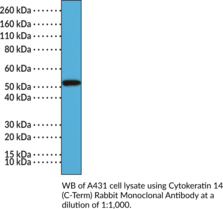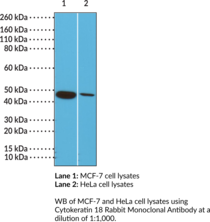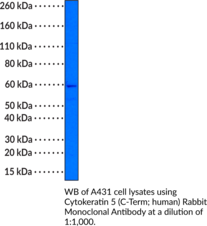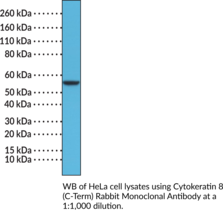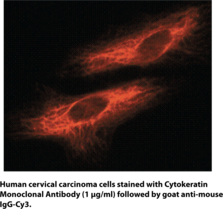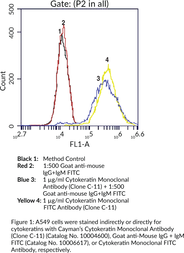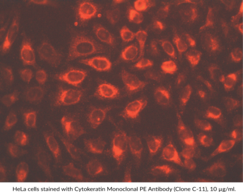Cayman
Showing 16951–17100 of 45550 results
-
The cytochalasins are cell-permeable fungal metabolites which inhibit actin polymerization.{21305,21310,21312,21316} This interferes with such diverse processes as cell movement, growth, phagocytosis, degranulation, and secretion.{21307,21313,21306,21315} Cytochalasin A is an oxidized analog of cytochalasin B which uniquely inhibits HIV-1 protease (IC50 = 3 μM).{21211} Cytochalasins A and B differ from other cytochalasins in being able to rapidly and reversibly inhibit glucose transport by competitively binding glucose transporters (Ki = 4.0 and 0.6 μM, respectively).{21309,21308} Cytochalasin A also induces the phosphorylation of the tyrosine phosphatase PTP3 of Dictyostelium, activating STATc.{21304}
Brand:CaymanSKU:11327 - 5 mgAvailable on backorder
Cytochalasin B is a cell-permeable mycotoxin which binds to the barbed end of actin, reversibly inhibiting the elongation and shortening of actin filaments.{20528} By disrupting actin polymerization, cytochalasin B blocks diverse cellular functions, including cell division, migration, phagocytosis, exocytosis, chemotaxis, and glucose transport.{20527,20526,20524} Cytochalasin B is broadly used in cytological studies involving any of these many processes that depend on actin polymerization.{20525,20530,20529}
Brand:CaymanSKU:11328 - 1 mgAvailable on backorder
Cytochalasin B is a cell-permeable mycotoxin which binds to the barbed end of actin, reversibly inhibiting the elongation and shortening of actin filaments.{20528} By disrupting actin polymerization, cytochalasin B blocks diverse cellular functions, including cell division, migration, phagocytosis, exocytosis, chemotaxis, and glucose transport.{20527,20526,20524} Cytochalasin B is broadly used in cytological studies involving any of these many processes that depend on actin polymerization.{20525,20530,20529}
Brand:CaymanSKU:11328 - 10 mgAvailable on backorder
Cytochalasin B is a cell-permeable mycotoxin which binds to the barbed end of actin, reversibly inhibiting the elongation and shortening of actin filaments.{20528} By disrupting actin polymerization, cytochalasin B blocks diverse cellular functions, including cell division, migration, phagocytosis, exocytosis, chemotaxis, and glucose transport.{20527,20526,20524} Cytochalasin B is broadly used in cytological studies involving any of these many processes that depend on actin polymerization.{20525,20530,20529}
Brand:CaymanSKU:11328 - 5 mgAvailable on backorder
The cytochalasins are cell-permeable fungal metabolites that inhibit actin polymerization.{21305,21310,21312,21316} This interferes with such diverse processes as cell movement, growth, phagocytosis, degranulation, and secretion.{21307,21313,21306,21315} Cytochalasin C has been shown to be 10 times less toxic in mice than the related cytochalasin D (Item No. 11330), but with essentially the same biological effectiveness against cells in culture.{25080}
Brand:CaymanSKU:11329 - 1 mgAvailable on backorder
The cytochalasins are cell-permeable fungal metabolites that inhibit actin polymerization.{21305,21310,21312,21316} This interferes with such diverse processes as cell movement, growth, phagocytosis, degranulation, and secretion.{21307,21313,21306,21315} Cytochalasin C has been shown to be 10 times less toxic in mice than the related cytochalasin D (Item No. 11330), but with essentially the same biological effectiveness against cells in culture.{25080}
Brand:CaymanSKU:11329 - 5 mgAvailable on backorder
The cytochalasins are cell-permeable fungal metabolites that inhibit actin polymerization.{21305,21310,21312,21316} This interferes with such diverse processes as cell movement, growth, phagocytosis, degranulation, and secretion.{21307,21313,21306,21315} Cytochalasin D is a cell-permeable inhibitor that binds actin filaments, but not actin monomers, to inhibit polymerization at concentrations as low as 0.2 µM.{21310} In this way, it prevents the migration of tumor cells.{15841}
Brand:CaymanSKU:11330 - 1 mgAvailable on backorder
The cytochalasins are cell-permeable fungal metabolites that inhibit actin polymerization.{21305,21310,21312,21316} This interferes with such diverse processes as cell movement, growth, phagocytosis, degranulation, and secretion.{21307,21313,21306,21315} Cytochalasin D is a cell-permeable inhibitor that binds actin filaments, but not actin monomers, to inhibit polymerization at concentrations as low as 0.2 µM.{21310} In this way, it prevents the migration of tumor cells.{15841}
Brand:CaymanSKU:11330 - 10 mgAvailable on backorder
The cytochalasins are cell-permeable fungal metabolites that inhibit actin polymerization.{21305,21310,21312,21316} This interferes with such diverse processes as cell movement, growth, phagocytosis, degranulation, and secretion.{21307,21313,21306,21315} Cytochalasin D is a cell-permeable inhibitor that binds actin filaments, but not actin monomers, to inhibit polymerization at concentrations as low as 0.2 µM.{21310} In this way, it prevents the migration of tumor cells.{15841}
Brand:CaymanSKU:11330 - 5 mgAvailable on backorder
The cytochalasins are cell-permeable fungal metabolites which inhibit actin polymerization.{21305,21310,21312,21316} This interferes with such diverse processes as cell movement, growth, phagocytosis, degranulation, and secretion.{21307,21313,21306,21315} Cytochalasin E is an epoxide-containing analog of cytochalasin B (Item No. 11328) which potently and selectively inhibits the growth of endothelial cells (IC50 1 protease activity.{21309,21308,21211}
Brand:CaymanSKU:11331 - 1 mgAvailable on backorder
The cytochalasins are cell-permeable fungal metabolites which inhibit actin polymerization.{21305,21310,21312,21316} This interferes with such diverse processes as cell movement, growth, phagocytosis, degranulation, and secretion.{21307,21313,21306,21315} Cytochalasin E is an epoxide-containing analog of cytochalasin B (Item No. 11328) which potently and selectively inhibits the growth of endothelial cells (IC50 1 protease activity.{21309,21308,21211}
Brand:CaymanSKU:11331 - 10 mgAvailable on backorder
The cytochalasins are cell-permeable fungal metabolites which inhibit actin polymerization.{21305,21310,21312,21316} This interferes with such diverse processes as cell movement, growth, phagocytosis, degranulation, and secretion.{21307,21313,21306,21315} Cytochalasin E is an epoxide-containing analog of cytochalasin B (Item No. 11328) which potently and selectively inhibits the growth of endothelial cells (IC50 1 protease activity.{21309,21308,21211}
Brand:CaymanSKU:11331 - 5 mgAvailable on backorder
The cytochalasins are cell-permeable fungal metabolites that inhibit actin polymerization.{21305,21310,21312,21316} This interferes with such diverse processes as cell movement, growth, phagocytosis, degranulation, and secretion.{21307,21313,21306,21315} Cytochalasin H is a potent inhibitor of actin incorporation into filaments.{25080,29763} Like cytochalasin D (Item No. 11330), it also increases the steady-state diffusion coefficients of filaments, suggesting that it stimulates filament shortening.{25080} Cytochalasin H suppresses the production of reactive oxygen species by stimulated human neutrophils, blocks endocytosis of CD59 in lymphocytes, and shows anti-angiogenic activity both in vitro and in vivo.{29673,29761,29762}
Brand:CaymanSKU:-Available on backorder
The cytochalasins are cell-permeable fungal metabolites that inhibit actin polymerization.{21305,21310,21312,21316} This interferes with such diverse processes as cell movement, growth, phagocytosis, degranulation, and secretion.{21307,21313,21306,21315} Cytochalasin H is a potent inhibitor of actin incorporation into filaments.{25080,29763} Like cytochalasin D (Item No. 11330), it also increases the steady-state diffusion coefficients of filaments, suggesting that it stimulates filament shortening.{25080} Cytochalasin H suppresses the production of reactive oxygen species by stimulated human neutrophils, blocks endocytosis of CD59 in lymphocytes, and shows anti-angiogenic activity both in vitro and in vivo.{29673,29761,29762}
Brand:CaymanSKU:-Available on backorder
The cytochalasins are cell-permeable fungal metabolites that inhibit actin polymerization.{21305,21310,21312,21316} This interferes with such diverse processes as cell movement, growth, phagocytosis, degranulation, and secretion.{21307,21313,21306,21315} Cytochalasin J is a deacetylated analog of cytochalasin H that weakly inhibits actin assembly but significantly alters mitotic spindle microtubule organization and kinetochore structure.{25080,29674} Like cytochalasin H, cytochalasin J suppresses the production of reactive oxygen species by stimulated human neutrophils.{29673}
Brand:CaymanSKU:-Available on backorder
The cytochalasins are cell-permeable fungal metabolites that inhibit actin polymerization.{21305,21310,21312,21316} This interferes with such diverse processes as cell movement, growth, phagocytosis, degranulation, and secretion.{21307,21313,21306,21315} Cytochalasin J is a deacetylated analog of cytochalasin H that weakly inhibits actin assembly but significantly alters mitotic spindle microtubule organization and kinetochore structure.{25080,29674} Like cytochalasin H, cytochalasin J suppresses the production of reactive oxygen species by stimulated human neutrophils.{29673}
Brand:CaymanSKU:-Available on backorder
Brand:CaymanSKU:700952 - 3 mgAvailable on backorder
Cytokeratin 14 (CK14) is a type I acidic epithelial intermediate filament protein.{59574} It is composed of a central rod containing four α-helical domains, which are important for self-assembly, and non-helical head and tail domains at the N- and C-termini, respectively.{59575,59576} CK14 is expressed in stratified squamous epithelial cells, keratinocytes, and myoepithelial cells in the basal layer of the epidermis and is an integral component of the epithelial cell cytoskeleton.{59574,59577,59578} It dimerizes with the type II basic epithelial intermediate filament protein CK5 via heptad repeats in the central rod domain to form a network of filament bundles throughout the cytoplasm.{59575,59576} Increased tumor levels of CK14 have been found in patients with squamous cell carcinomas of the bladder, lung, or cervix.{59579} Mutations in the gene encoding CK14 have been found in patients with epidermolysis bullosa simplex (EBS), a disorder characterized by skin blistering.{58059} Cayman’s Cytokeratin 14 (C-Term) Rabbit Monoclonal Antibody can be used for immunohistochemistry (IHC) and Western blot (WB) applications.
Brand:CaymanSKU:32266 - 100 µlAvailable on backorder
Immunogen: Peptide from the C-terminal region of human cytokeratin 14 • Host: Rabbit • Species Reactivity: (+) Human • Cross Reactivity: (+) Cytokeratin 14 • Applications: IHC, WB
Brand:CaymanSKU:32266- 100 µlAvailable on backorder
Immunogen: Peptide from the C-terminal region of human cytokeratin 14 • Host: Rabbit • Species Reactivity: (+) Human • Cross Reactivity: (+) Cytokeratin 14 • Applications: IHC, WB
Brand:CaymanSKU:32266- 100 µlCytokeratin 18 (CK18) is an intermediate filament protein and a member of the cytokeratin protein family.{59484} It is a type I acidic cytokeratin expressed in epithelial tissues, including those found in liver, lung, kidney, pancreas, and the gastrointestinal tract, and is localized in the cytoplasm and perinuclear region. CK18 is co-expressed with the type II neutral-basic cytokeratin CK8, with which it forms intermediate filaments essential to cytoplasmic structure. During apoptosis, CK18 is cleaved by caspases and released from the cell, and is commonly used as a marker of epithelial cell death.{59639} Plasma levels of CK18 positively correlate with the magnitude of hepatocyte apoptosis in patients with non-alcoholic fatty liver disease (NAFLD) and are independently predictive of non-alcoholic steatohepatitis (NASH).{59640} Serum levels of CK18 are elevated in patients with cardiometabolic disorders, including diabetes and hypertension, in an NAFLD-independent manner.{59639} CK18 tumor expression positively correlates with poorly differentiated oral squamous cell carcinoma (OSCC) tumors and poor prognosis.{59641} Cayman’s Cytokeratin 18 Rabbit Monoclonal Antibody can be used for immunohistochemistry (IHC) and Western blot (WB) applications.
Brand:CaymanSKU:32229 - 100 µlAvailable on backorder
Immunogen: Peptide from the N-terminal region of human cytokeratin 18 • Host: Rabbit • Species Reactivity: (+) Human • Cross Reactivity: (+) Cytokeratin 18 • Applications: IHC, WB
Brand:CaymanSKU:32229- 100 µlAvailable on backorder
Immunogen: Peptide from the N-terminal region of human cytokeratin 18 • Host: Rabbit • Species Reactivity: (+) Human • Cross Reactivity: (+) Cytokeratin 18 • Applications: IHC, WB
Brand:CaymanSKU:32229- 100 µlImmunogen: Peptide from the C-terminal region of human cytokeratin 5 • Host: Rabbit • Species Reactivity: (+) Human • Cross Reactivity: (+) Cytokeratin 5; (-) Cytokeratin 6 • Applications: IHC, WB
Brand:CaymanSKU:32190- 1 mlAvailable on backorder
Immunogen: Peptide from the C-terminal region of human cytokeratin 5 • Host: Rabbit • Species Reactivity: (+) Human • Cross Reactivity: (+) Cytokeratin 5; (-) Cytokeratin 6 • Applications: IHC, WB
Brand:CaymanSKU:32190- 1 mlCytokeratin 5 is a type II epithelial intermediate filament protein.{15723} It is composed of a central rod containing four α-helical domains, which are important for self-assembly, and non-helical head and tail domains at the N- and C-termini, respectively. Cytokeratin 5 is expressed in basal keratinocytes in the epidermis and is an integral component of the epithelial cell cytoskeleton.{58059} It dimerizes with the type I epithelial intermediate filament protein cytokeratin 14 via heptad repeats in the central rod domain to form a network of filament bundles throughout the cytoplasm.{58060,15723} Cytokeratin 5 interacts with β-catenin in estrogen receptor-positive breast cancer cells and promotes the reduction of β-catenin levels at the cell surface in vitro and in a patient-derived xenograft (PDX) mouse model of breast cancer.{58061} The expression of cytokeratin 5 in cancer cells predicts poor prognosis in estrogen receptor-positive breast cancer.{58061} Mutations in the tail or head domains of cytokeratin 5 induce cytoskeletal abnormalities and keratin aggregation and are associated with epidermolysis bullosa simplex (EBS) while head domain mutations are associated with Dowling-Degos disease.{58059,15723,58060} Cayman’s Cytokeratin 5 (C-Term; human) Rabbit Monoclonal Antibody can be used for immunohistochemistry (IHC) and Western blot (WB) applications.
Brand:CaymanSKU:32190 - 1 mlAvailable on backorder
Immunogen: Peptide from the C-terminal region of human cytokeratin 5 • Host: Rabbit • Species Reactivity: (+) Human • Cross Reactivity: (+) Cytokeratin 5; (-) Cytokeratin 6 • Applications: IHC, WB
Brand:CaymanSKU:32190- 100 µlAvailable on backorder
Immunogen: Peptide from the C-terminal region of human cytokeratin 5 • Host: Rabbit • Species Reactivity: (+) Human • Cross Reactivity: (+) Cytokeratin 5; (-) Cytokeratin 6 • Applications: IHC, WB
Brand:CaymanSKU:32190- 100 µlCytokeratin 5 is a type II epithelial intermediate filament protein.{15723} It is composed of a central rod containing four α-helical domains, which are important for self-assembly, and non-helical head and tail domains at the N- and C-termini, respectively. Cytokeratin 5 is expressed in basal keratinocytes in the epidermis and is an integral component of the epithelial cell cytoskeleton.{58059} It dimerizes with the type I epithelial intermediate filament protein cytokeratin 14 via heptad repeats in the central rod domain to form a network of filament bundles throughout the cytoplasm.{58060,15723} Cytokeratin 5 interacts with β-catenin in estrogen receptor-positive breast cancer cells and promotes the reduction of β-catenin levels at the cell surface in vitro and in a patient-derived xenograft (PDX) mouse model of breast cancer.{58061} The expression of cytokeratin 5 in cancer cells predicts poor prognosis in estrogen receptor-positive breast cancer.{58061} Mutations in the tail or head domains of cytokeratin 5 induce cytoskeletal abnormalities and keratin aggregation and are associated with epidermolysis bullosa simplex (EBS) while head domain mutations are associated with Dowling-Degos disease.{58059,15723,58060} Cayman’s Cytokeratin 5 (C-Term; human) Rabbit Monoclonal Antibody can be used for immunohistochemistry (IHC) and Western blot (WB) applications.
Brand:CaymanSKU:32190 - 100 µlAvailable on backorder
Cytokeratin 7 (CK7) is an intermediate filament protein and a member of the cytokeratin protein family.{59484,59485} It is a type II neutral-basic cytokeratin expressed in ductal, glandular, and transitional epithelial tissues, as well as endothelial cells, but not stratified squamous epithelia, and is localized to the cytoplasm.{59485,59486} CK7 is found in various tumors, including ductal, lobular, and mucinous carcinomas, as well as ovarian, but not colorectal, adenocarcinomas, malignant mesotheliomas, and transitional cell carcinomas.{59486} It is also found in chromophobe renal cell carcinomas but not oncocytoma and conventional carcinomas and has been used as a biomarker for differentiation of tumor origin.{59487} Hepatocyte expression of CK7 is positively correlated with fibrosis stage in patients with hepatitis B and hepatitis C.{59488} Cayman’s Cytokeratin 7 (C-Term) Rabbit Monoclonal Antibody can be used for immunohistochemistry (IHC) and Western blot (WB) applications.
Brand:CaymanSKU:32233 - 100 µlAvailable on backorder
Immunogen: Peptide from the C-terminal region of human cytokeratin 7 • Host: Rabbit • Species Reactivity: (+) Human • Cross Reactivity: (+) Cytokeratin 7 • Applications: IHC, WB
Brand:CaymanSKU:32233- 100 µlAvailable on backorder
Immunogen: Peptide from the C-terminal region of human cytokeratin 7 • Host: Rabbit • Species Reactivity: (+) Human • Cross Reactivity: (+) Cytokeratin 7 • Applications: IHC, WB
Brand:CaymanSKU:32233- 100 µlCytokeratin 8 is a type II epithelial intermediate filament protein.{15723} It is composed of a central rod containing four α-helical domains, which are important for self-assembly, and non-helical head and tail domains at the N- and C-termini, respectively. Cytokeratin 8 is expressed in single-layered epithelial cells and epithelial-derived tumor cells.{59194} It dimerizes with the type I epithelial intermediate filament protein cytokeratin 18 to form a network of filament bundles throughout the cytoplasm.{59195} The tail of cytokeratin 8 binds to plasminogen and mediates invasiveness of cancer cells in vitro.{59196} A null mutation in KRT8, the gene encoding cytokeratin 8, is embryonic lethal in C57BL/6 x 129Sv, but not FVB/N, mice, which develop colorectal hyperplasia.{59197} Substitution mutations in KRT8, corresponding to residues in the head domain of the protein, disrupt filament reorganization following oxidative and non-oxidative stress in vitro and are associated with cryptogenic liver disease.{59194} Intratumoral levels of cytokeratin 8 and -18 are correlated with poor prognosis in patients with squamous cell carcinomas of the oral cavity.{59198} Cayman’s Cytokeratin 8 (C-Term) Rabbit Monoclonal Antibody can be used for immunohistochemistry (IHC) and Western blot (WB) applications.
Brand:CaymanSKU:32216 - 100 µlAvailable on backorder
Immunogen: Peptide from the C-terminal region of human cytokeratin 8 • Host: Rabbit • Species Reactivity: (+) Human • Cross Reactivity: (+) Cytokeratin 8 • Applications: IHC, WB
Brand:CaymanSKU:32216- 100 µlAvailable on backorder
Immunogen: Peptide from the C-terminal region of human cytokeratin 8 • Host: Rabbit • Species Reactivity: (+) Human • Cross Reactivity: (+) Cytokeratin 8 • Applications: IHC, WB
Brand:CaymanSKU:32216- 100 µlHost: mouse, clone C-11 • Cross Reactivity: (+) human cytokeratins 4, 5, 6, 8, 10, 13, and 18 • Application(s):FC, IF, IHC (paraffin-embedded tissue), and WB • Cytokeratins make up a large family of proteins classified as intermediate filament polypeptides. They are subdivided into type I (acidic) and type II (basic/neutral) proteins. Under normal conditions, these proteins are found in epithelial cells as type I/type II pairs. These pairs provide cellular support as well as contribute to more dynamic processes. They undergo extensive post translational modifications, such as phosphorylation, and are important for cancer diagnostics.
Brand:CaymanSKU:10004600- 1 eaAvailable on backorder
Host: mouse, clone C-11 • Cross Reactivity: (+) human cytokeratins 4, 5, 6, 8, 10, 13, and 18 • Application(s):FC, IF, IHC (paraffin-embedded tissue), and WB • Cytokeratins make up a large family of proteins classified as intermediate filament polypeptides. They are subdivided into type I (acidic) and type II (basic/neutral) proteins. Under normal conditions, these proteins are found in epithelial cells as type I/type II pairs. These pairs provide cellular support as well as contribute to more dynamic processes. They undergo extensive post translational modifications, such as phosphorylation, and are important for cancer diagnostics.
Brand:CaymanSKU:10004600- 1 eaThis pan-cytokeratin antibody detects cytokeratin isoforms 4, 5, 6, 8, 10, 13, and 18.{11908} Cytokeratins make up a large family of proteins classifed as intermediate filament polypeptides.{11908,15722} They are subdivided into type I (acidic) and type II (basic/neutral) proteins.{15723} Under normal conditions, these proteins are found in epithelial cells as type I/type II pairs.{11908,15740} These pairs provide cellular support as well as contributing to more dynamic processes. They undergo extensive post translational modifications, such as phosphorylation, and are important for cancer diagnostics.{15740,15721} This antibody recognizes human cytokeratins 4, 5, 6, 8, 10, 13, and 18.{11908} Accordingly the molecular migration is isoform dependent and expected to range from 40 to 70 kDa depending upon the cytokeratin composition of the sample.
Brand:CaymanSKU:10004600 - 1 eaAvailable on backorder
Host: Mouse, clone C-11 • Cross Reactivity: (+) Human cytokeratins 4, 5, 6, 8, 10, 13, and 18 • Application(s): FC and IF • Cytokeratins are intermediate filament polypeptides that provide cellular support to epithelial cells as well as contribute to more dynamic processes. Cytokeratins are differentially expressed in normal and cancer cells.
Brand:CaymanSKU:10349- 1 eaThis pan-cytokeratin antibody detects cytokeratin isoforms 4, 5, 6, 8, 10, 13, and 18.{11908} Cytokeratins make up a large family of proteins classified as intermediate filament polypeptides.{11908,15722} They are subdivided into type I (acidic) and type II (basic/neutral) proteins.{15723} Under normal conditions, these proteins are found in epithelial cells as type I/type II pairs.{11908,15740} These pairs provide cellular support as well as contributing to more dynamic processes. Cytokeratins undergo extensive post translational modifications, such as phosphorylation, and are differentially expressed in normal and cancer cells.{15740,15721}
Brand:CaymanSKU:10349 - 1 eaAvailable on backorder
Host: Mouse, clone C-11 • Cross Reactivity: (+) Human cytokeratins 4, 5, 6, 8, 10, 13, and 18 • Application(s): FC and IF • Cytokeratins are intermediate filament polypeptides that provide cellular support to epithelial cells as well as contribute to more dynamic processes. Cytokeratins are differentially expressed in normal and cancer cells.
Brand:CaymanSKU:10349- 1 eaAvailable on backorder
Brand:CaymanSKU:10478- 1 eaThis pan-cytokeratin antibody detects cytokeratin isoforms 4, 5, 6, 8, 10, 13, and 18.{11908} Cytokeratins make up a large family of proteins classified as intermediate filament polypeptides.{11908,15722} They are subdivided into type I (acidic) and type II (basic/neutral) proteins.{15723} Under normal conditions, these proteins are found in epithelial cells as type I/type II pairs.{11908,15740} These pairs provide cellular support as well as contribute to more dynamic processes. Cytokeratins undergo extensive post translational modifications, such as phosphorylation, and are differentially expressed in normal and cancer cells.{15740,15721}
Brand:CaymanSKU:10478 - 1 eaAvailable on backorder
Brand:CaymanSKU:10478- 1 eaAvailable on backorder
Cytosporone B is a naturally occurring agonist for the nuclear receptor Nur77 (IC50 = 0.278 nM).{28698} Activation of Nur77 with cytosporone B induces the expression of Nur77-dependent genes, including the gene for Nur77 itself.{28698} Signaling through Nur77 induces apoptosis in cancer cells and retards xenograft tumor growth.{28698} It also induces genes related to gluconeogenesis and decreases atherosclerosis progression in mice fed a high fat and high cholesterol diet.{28698,28695} Cytosporone B is brain penetrant and aggravates early brain injury in rats when given (13 mg/kg intraperitoneally) after experimentally-induced subarachnoid hemorrhage.{28694} Cytosporone B also has antibacterial properties.{28693,28696}
Brand:CaymanSKU:-Available on backorder
Cytosporone B is a naturally occurring agonist for the nuclear receptor Nur77 (IC50 = 0.278 nM).{28698} Activation of Nur77 with cytosporone B induces the expression of Nur77-dependent genes, including the gene for Nur77 itself.{28698} Signaling through Nur77 induces apoptosis in cancer cells and retards xenograft tumor growth.{28698} It also induces genes related to gluconeogenesis and decreases atherosclerosis progression in mice fed a high fat and high cholesterol diet.{28698,28695} Cytosporone B is brain penetrant and aggravates early brain injury in rats when given (13 mg/kg intraperitoneally) after experimentally-induced subarachnoid hemorrhage.{28694} Cytosporone B also has antibacterial properties.{28693,28696}
Brand:CaymanSKU:-Available on backorder
Cytosporone B is a naturally occurring agonist for the nuclear receptor Nur77 (IC50 = 0.278 nM).{28698} Activation of Nur77 with cytosporone B induces the expression of Nur77-dependent genes, including the gene for Nur77 itself.{28698} Signaling through Nur77 induces apoptosis in cancer cells and retards xenograft tumor growth.{28698} It also induces genes related to gluconeogenesis and decreases atherosclerosis progression in mice fed a high fat and high cholesterol diet.{28698,28695} Cytosporone B is brain penetrant and aggravates early brain injury in rats when given (13 mg/kg intraperitoneally) after experimentally-induced subarachnoid hemorrhage.{28694} Cytosporone B also has antibacterial properties.{28693,28696}
Brand:CaymanSKU:-Available on backorder
Cytosporone B is a naturally occurring agonist for the nuclear receptor Nur77 (IC50 = 0.278 nM).{28698} Activation of Nur77 with cytosporone B induces the expression of Nur77-dependent genes, including the gene for Nur77 itself.{28698} Signaling through Nur77 induces apoptosis in cancer cells and retards xenograft tumor growth.{28698} It also induces genes related to gluconeogenesis and decreases atherosclerosis progression in mice fed a high fat and high cholesterol diet.{28698,28695} Cytosporone B is brain penetrant and aggravates early brain injury in rats when given (13 mg/kg intraperitoneally) after experimentally-induced subarachnoid hemorrhage.{28694} Cytosporone B also has antibacterial properties.{28693,28696}
Brand:CaymanSKU:-Available on backorder
Cytostatin is a natural antitumor inhibitor of cell adhesion to extracellular matrix, blocking adhesion of B16 melanoma cells to laminin and collagen type IV in vitro (IC50s = 1.3 and 1.4 µg/ml, respectively) and B16 cells metastatic activity in mice.{31268,31270} It induces apoptosis of FS3 mouse fibrosarcoma cells (IC50 = 3.1 µg/ml).{31272} Cytostatin potently and selectively inhibits protein phosphatase 2A (PP2A; IC50 = 29 nM against the catalytic subunit), while having no effect against PP1, PP2B, or PP5.{31269,31271}
Brand:CaymanSKU:19602 -Available on backorder
CytoTrace™ Orange CMTMR is a rhodamine-based, cell-permeant, vital fluorescent dye that is retained by cells for prolonged periods (>72 hours) and is passed to daughter cells. Cells loaded with long-lasting dyes, including CMTMR, are used to follow cell trafficking and cell-to-cell interactions in vivo.{33970,33971,33972} They have also been used to estimate the growth of implanted tumor spheroids.{33969} CytoTrace™ Orange CMTMR displays excitation/emission maxima of 541/565 nm, respectively.
Brand:CaymanSKU:20696 -Available on backorder
CZ415 is an inhibitor of mammalian target of rapamycin (mTOR; Kd = 6.3 nM).{47760} It is 1,000-fold selective for mTOR over a panel of 285 kinases. CZ415 inhibits phosphorylation of S6 ribosomal protein (S6RP) and Akt in HEK293T cells (IC50s = 14.5 and 14.8 nM, respectively). It inhibits IFN-γ secretion in IL-2, anti-CD3, and anti-CD28 antibody-stimulated human whole blood (IC50 = 226 nM). CZ415 (10 mg/kg) reduces fore paw joint erythema and swelling in a mouse model of collagen-induced arthritis. It also inhibits intratumor mTOR activity and reduces tumor growth in an OCC-1 oral cavity carcinoma mouse xenograft model when administered at a dose of 20 mg/kg.{47761}
Brand:CaymanSKU:27668 - 1 mgAvailable on backorder
CZ415 is an inhibitor of mammalian target of rapamycin (mTOR; Kd = 6.3 nM).{47760} It is 1,000-fold selective for mTOR over a panel of 285 kinases. CZ415 inhibits phosphorylation of S6 ribosomal protein (S6RP) and Akt in HEK293T cells (IC50s = 14.5 and 14.8 nM, respectively). It inhibits IFN-γ secretion in IL-2, anti-CD3, and anti-CD28 antibody-stimulated human whole blood (IC50 = 226 nM). CZ415 (10 mg/kg) reduces fore paw joint erythema and swelling in a mouse model of collagen-induced arthritis. It also inhibits intratumor mTOR activity and reduces tumor growth in an OCC-1 oral cavity carcinoma mouse xenograft model when administered at a dose of 20 mg/kg.{47761}
Brand:CaymanSKU:27668 - 10 mgAvailable on backorder
CZ415 is an inhibitor of mammalian target of rapamycin (mTOR; Kd = 6.3 nM).{47760} It is 1,000-fold selective for mTOR over a panel of 285 kinases. CZ415 inhibits phosphorylation of S6 ribosomal protein (S6RP) and Akt in HEK293T cells (IC50s = 14.5 and 14.8 nM, respectively). It inhibits IFN-γ secretion in IL-2, anti-CD3, and anti-CD28 antibody-stimulated human whole blood (IC50 = 226 nM). CZ415 (10 mg/kg) reduces fore paw joint erythema and swelling in a mouse model of collagen-induced arthritis. It also inhibits intratumor mTOR activity and reduces tumor growth in an OCC-1 oral cavity carcinoma mouse xenograft model when administered at a dose of 20 mg/kg.{47761}
Brand:CaymanSKU:27668 - 25 mgAvailable on backorder
CZ415 is an inhibitor of mammalian target of rapamycin (mTOR; Kd = 6.3 nM).{47760} It is 1,000-fold selective for mTOR over a panel of 285 kinases. CZ415 inhibits phosphorylation of S6 ribosomal protein (S6RP) and Akt in HEK293T cells (IC50s = 14.5 and 14.8 nM, respectively). It inhibits IFN-γ secretion in IL-2, anti-CD3, and anti-CD28 antibody-stimulated human whole blood (IC50 = 226 nM). CZ415 (10 mg/kg) reduces fore paw joint erythema and swelling in a mouse model of collagen-induced arthritis. It also inhibits intratumor mTOR activity and reduces tumor growth in an OCC-1 oral cavity carcinoma mouse xenograft model when administered at a dose of 20 mg/kg.{47761}
Brand:CaymanSKU:27668 - 5 mgAvailable on backorder
CZC-24832 is an inhibitor of PI3K with selectivity for the γ isoform (IC50 = 1.0 μM in a PI3Kγ-dependent fMLP-induced neutrophil migration assay) with limited off target effects in kinome profiling of 154 kinases and 922 other proteins.{32561} This compound demonstrates efficacy in in vitro and in vivo models of inflammation.{32561}
Brand:CaymanSKU:-CZC-24832 is an inhibitor of PI3K with selectivity for the γ isoform (IC50 = 1.0 μM in a PI3Kγ-dependent fMLP-induced neutrophil migration assay) with limited off target effects in kinome profiling of 154 kinases and 922 other proteins.{32561} This compound demonstrates efficacy in in vitro and in vivo models of inflammation.{32561}
Brand:CaymanSKU:-CZC-24832 is an inhibitor of PI3K with selectivity for the γ isoform (IC50 = 1.0 μM in a PI3Kγ-dependent fMLP-induced neutrophil migration assay) with limited off target effects in kinome profiling of 154 kinases and 922 other proteins.{32561} This compound demonstrates efficacy in in vitro and in vivo models of inflammation.{32561}
Brand:CaymanSKU:-CZC-24832 is an inhibitor of PI3K with selectivity for the γ isoform (IC50 = 1.0 μM in a PI3Kγ-dependent fMLP-induced neutrophil migration assay) with limited off target effects in kinome profiling of 154 kinases and 922 other proteins.{32561} This compound demonstrates efficacy in in vitro and in vivo models of inflammation.{32561}
Brand:CaymanSKU:-CZC-25146 is a potent inhibitor of leucine-rich repeat kinase 2 (LRRK2; IC50 = 4.76 nM for the human recombinant kinase).{32556} It also inhibits LRRK2G2019S, a mutant linked to neurotoxicity and Parkinson’s disease, with an IC50 value of 6.87 nM. CZC-25146 is selective for LRRK2 over a panel of kinases in HeLa cell lysates, Jurkat/Ramos mixed cell lysates, as well as whole mouse brain extracts (IC50s = >2 μM). It reduces LRRK2G2019S-induced cell injury in rat primary cortical neurons.
Brand:CaymanSKU:22931 - 1 mgAvailable on backorder
CZC-25146 is a potent inhibitor of leucine-rich repeat kinase 2 (LRRK2; IC50 = 4.76 nM for the human recombinant kinase).{32556} It also inhibits LRRK2G2019S, a mutant linked to neurotoxicity and Parkinson’s disease, with an IC50 value of 6.87 nM. CZC-25146 is selective for LRRK2 over a panel of kinases in HeLa cell lysates, Jurkat/Ramos mixed cell lysates, as well as whole mouse brain extracts (IC50s = >2 μM). It reduces LRRK2G2019S-induced cell injury in rat primary cortical neurons.
Brand:CaymanSKU:22931 - 10 mgAvailable on backorder
CZC-25146 is a potent inhibitor of leucine-rich repeat kinase 2 (LRRK2; IC50 = 4.76 nM for the human recombinant kinase).{32556} It also inhibits LRRK2G2019S, a mutant linked to neurotoxicity and Parkinson’s disease, with an IC50 value of 6.87 nM. CZC-25146 is selective for LRRK2 over a panel of kinases in HeLa cell lysates, Jurkat/Ramos mixed cell lysates, as well as whole mouse brain extracts (IC50s = >2 μM). It reduces LRRK2G2019S-induced cell injury in rat primary cortical neurons.
Brand:CaymanSKU:22931 - 25 mgAvailable on backorder
CZC-25146 is a potent inhibitor of leucine-rich repeat kinase 2 (LRRK2; IC50 = 4.76 nM for the human recombinant kinase).{32556} It also inhibits LRRK2G2019S, a mutant linked to neurotoxicity and Parkinson’s disease, with an IC50 value of 6.87 nM. CZC-25146 is selective for LRRK2 over a panel of kinases in HeLa cell lysates, Jurkat/Ramos mixed cell lysates, as well as whole mouse brain extracts (IC50s = >2 μM). It reduces LRRK2G2019S-induced cell injury in rat primary cortical neurons.
Brand:CaymanSKU:22931 - 5 mgAvailable on backorder
CZC-54252 is an inhibitor of leucine-rich repeat kinase 2 (LRRK2; IC50s = 1.28 and 1.85 nM for wild-type and G2019S mutant forms of LRRK2, respectively).{32555} It has been shown to protect against neuronal injury induced by Parkinson’s disease-related LRRK2-G2019S mutant activity in primary human neurons with an EC50 value of 1 nM.{32556}
Brand:CaymanSKU:-Available on backorder
CZC-54252 is an inhibitor of leucine-rich repeat kinase 2 (LRRK2; IC50s = 1.28 and 1.85 nM for wild-type and G2019S mutant forms of LRRK2, respectively).{32555} It has been shown to protect against neuronal injury induced by Parkinson’s disease-related LRRK2-G2019S mutant activity in primary human neurons with an EC50 value of 1 nM.{32556}
Brand:CaymanSKU:-Available on backorder
CZC-54252 is an inhibitor of leucine-rich repeat kinase 2 (LRRK2; IC50s = 1.28 and 1.85 nM for wild-type and G2019S mutant forms of LRRK2, respectively).{32555} It has been shown to protect against neuronal injury induced by Parkinson’s disease-related LRRK2-G2019S mutant activity in primary human neurons with an EC50 value of 1 nM.{32556}
Brand:CaymanSKU:-Available on backorder
CZC-54252 is an inhibitor of leucine-rich repeat kinase 2 (LRRK2; IC50s = 1.28 and 1.85 nM for wild-type and G2019S mutant forms of LRRK2, respectively).{32555} It has been shown to protect against neuronal injury induced by Parkinson’s disease-related LRRK2-G2019S mutant activity in primary human neurons with an EC50 value of 1 nM.{32556}
Brand:CaymanSKU:-Available on backorder
CZC-8004 is an aminopyrimidine that binds a range of tyrosine kinases, including ABL, BTK, FAK, FER, JAK1, SRC, SYK, TEC, TNK1, TYK2, and YES.{27326} It inhibits these kinases at low micromolar concentrations and can be immobilized to capture and purify these enzymes.{27326}
Brand:CaymanSKU:-Out of stock
CZC-8004 is an aminopyrimidine that binds a range of tyrosine kinases, including ABL, BTK, FAK, FER, JAK1, SRC, SYK, TEC, TNK1, TYK2, and YES.{27326} It inhibits these kinases at low micromolar concentrations and can be immobilized to capture and purify these enzymes.{27326}
Brand:CaymanSKU:-Out of stock
CZC-8004 is an aminopyrimidine that binds a range of tyrosine kinases, including ABL, BTK, FAK, FER, JAK1, SRC, SYK, TEC, TNK1, TYK2, and YES.{27326} It inhibits these kinases at low micromolar concentrations and can be immobilized to capture and purify these enzymes.{27326}
Brand:CaymanSKU:-Out of stock
CZC-8004 is an aminopyrimidine that binds a range of tyrosine kinases, including ABL, BTK, FAK, FER, JAK1, SRC, SYK, TEC, TNK1, TYK2, and YES.{27326} It inhibits these kinases at low micromolar concentrations and can be immobilized to capture and purify these enzymes.{27326}
Brand:CaymanSKU:-Out of stock
D 4476 is a cell-permeant inhibitor of casein kinase 1 (CK1; IC50 = 200 nM from S. pombe,{17330} 300 nM for CK1δ{17331}). It is a less effective inhibitor of PKD1 (IC50 = 9.1 μM) and p38α MAPK (IC50 = 5.8 μM), and only weakly affects the activities of a panel of kinases tested.{17331} D 4476 blocks CK1-mediated phosphorylation of FOXO1a,{17330} RhoB,{17333} and p53.{17334} As an inhibitor of ALK5, D 4476 prevents Smad3 activation and suppresses TGF-β1-induced gene expression without cytotoxicity in A498 cells.{16928}
Brand:CaymanSKU:-D 4476 is a cell-permeant inhibitor of casein kinase 1 (CK1; IC50 = 200 nM from S. pombe,{17330} 300 nM for CK1δ{17331}). It is a less effective inhibitor of PKD1 (IC50 = 9.1 μM) and p38α MAPK (IC50 = 5.8 μM), and only weakly affects the activities of a panel of kinases tested.{17331} D 4476 blocks CK1-mediated phosphorylation of FOXO1a,{17330} RhoB,{17333} and p53.{17334} As an inhibitor of ALK5, D 4476 prevents Smad3 activation and suppresses TGF-β1-induced gene expression without cytotoxicity in A498 cells.{16928}
Brand:CaymanSKU:-D 4476 is a cell-permeant inhibitor of casein kinase 1 (CK1; IC50 = 200 nM from S. pombe,{17330} 300 nM for CK1δ{17331}). It is a less effective inhibitor of PKD1 (IC50 = 9.1 μM) and p38α MAPK (IC50 = 5.8 μM), and only weakly affects the activities of a panel of kinases tested.{17331} D 4476 blocks CK1-mediated phosphorylation of FOXO1a,{17330} RhoB,{17333} and p53.{17334} As an inhibitor of ALK5, D 4476 prevents Smad3 activation and suppresses TGF-β1-induced gene expression without cytotoxicity in A498 cells.{16928}
Brand:CaymanSKU:-D 4476 is a cell-permeant inhibitor of casein kinase 1 (CK1; IC50 = 200 nM from S. pombe,{17330} 300 nM for CK1δ{17331}). It is a less effective inhibitor of PKD1 (IC50 = 9.1 μM) and p38α MAPK (IC50 = 5.8 μM), and only weakly affects the activities of a panel of kinases tested.{17331} D 4476 blocks CK1-mediated phosphorylation of FOXO1a,{17330} RhoB,{17333} and p53.{17334} As an inhibitor of ALK5, D 4476 prevents Smad3 activation and suppresses TGF-β1-induced gene expression without cytotoxicity in A498 cells.{16928}
Brand:CaymanSKU:-D-(+)-Glucose is a monosaccharide that occurs in nature and is used by organisms as an energy source. D-(+)-Glucose is the more common enantiomer of L-(–)-glucose (Item No. 20829).
Brand:CaymanSKU:23733 - 50 gAvailable on backorder
D-(+)-Glucose-13C6 is intended for use as an internal standard for the quantification of D-(+)-glucose (Item No. 23733) by GC- or LC-MS. D-(+)-Glucose is a monosaccharide that occurs in nature and is used by organisms as an energy source. D-(+)-Glucose is the more common enantiomer of L-(–)-glucose (Item No. 20829).
Brand:CaymanSKU:26707 - 1 gAvailable on backorder
D-(+)-Glucose-13C6 is intended for use as an internal standard for the quantification of D-(+)-glucose (Item No. 23733) by GC- or LC-MS. D-(+)-Glucose is a monosaccharide that occurs in nature and is used by organisms as an energy source. D-(+)-Glucose is the more common enantiomer of L-(–)-glucose (Item No. 20829).
Brand:CaymanSKU:26707 - 100 mgAvailable on backorder
D-(+)-Glucose-13C6 is intended for use as an internal standard for the quantification of D-(+)-glucose (Item No. 23733) by GC- or LC-MS. D-(+)-Glucose is a monosaccharide that occurs in nature and is used by organisms as an energy source. D-(+)-Glucose is the more common enantiomer of L-(–)-glucose (Item No. 20829).
Brand:CaymanSKU:26707 - 250 mgAvailable on backorder
D-(+)-Glucose-13C6 is intended for use as an internal standard for the quantification of D-(+)-glucose (Item No. 23733) by GC- or LC-MS. D-(+)-Glucose is a monosaccharide that occurs in nature and is used by organisms as an energy source. D-(+)-Glucose is the more common enantiomer of L-(–)-glucose (Item No. 20829).
Brand:CaymanSKU:26707 - 500 mgAvailable on backorder
D-(+)-Glyceraldehyde is an intermediate in carbohydrate metabolism. It is phosphorylated by triose kinase to produce D-glyceraldehyde 3-phosphate, an intermediate in glycolysis, gluconeogenesis, photosynthesis, and other metabolic pathways.{29575,29576,29577}
Brand:CaymanSKU:-Out of stock
D-(+)-Glyceraldehyde is an intermediate in carbohydrate metabolism. It is phosphorylated by triose kinase to produce D-glyceraldehyde 3-phosphate, an intermediate in glycolysis, gluconeogenesis, photosynthesis, and other metabolic pathways.{29575,29576,29577}
Brand:CaymanSKU:-Out of stock








